Are you eager to discover the authentic culture of Vietnam’s ethnic minority groups? Discover immersive experiences with SIXT.VN, from homestays to vibrant markets, and delve into the heart of Vietnamese heritage. SIXT.VN offers curated experiences that allow you to connect with local communities, savor traditional cuisine, and witness unique cultural practices. Prepare for an unforgettable journey into the soul of Vietnam, filled with cultural immersion, authentic encounters, and lasting memories.
1. Unveiling the Essence of Ethnic Minority Life in Vietnam
Vietnam, a land of captivating beauty and rich cultural diversity, is home to 54 officially recognized ethnic groups, each contributing uniquely to the nation’s vibrant tapestry. Experiencing the daily life of these communities offers an unparalleled opportunity to delve into their traditions, customs, and ways of life. Homestays and market visits stand out as exceptional avenues for authentic cultural immersion.
1.1. Why Immerse Yourself in Ethnic Minority Culture?
According to research from the Vietnam National Administration of Tourism in 2023, cultural tourism provides economic benefits for local communities, as tourists are willing to pay for Y, such as traditional handicrafts and homestays. A journey into the heart of ethnic minority communities transcends mere sightseeing; it’s about fostering genuine connections, understanding diverse perspectives, and contributing to the preservation of invaluable cultural heritage.
- Cultural Enrichment: Immerse yourself in traditions, customs, and artistic expressions passed down through generations.
- Personal Growth: Broaden your understanding of the world, challenge your assumptions, and develop empathy for diverse cultures.
- Sustainable Tourism: Support local economies and promote responsible travel practices that respect the environment and local communities.
1.2. Homestays: A Window into Daily Life
Homestays provide an intimate glimpse into the daily lives of ethnic minority families. According to a 2022 study by the Tourism Authority, homestays provide authentic cultural immersion. Unlike conventional hotels, homestays offer a chance to live alongside local families, share meals, participate in daily activities, and learn about their customs and beliefs firsthand.
1.2.1. What to Expect in a Homestay
- Warm Hospitality: Expect to be welcomed as a member of the family, sharing meals, stories, and laughter.
- Traditional Accommodation: Stay in traditional houses, often built with local materials and reflecting unique architectural styles.
- Authentic Cuisine: Savor home-cooked meals prepared with fresh, local ingredients, experiencing the unique flavors of the region.
- Cultural Exchange: Engage in conversations, learn basic phrases in the local language, and participate in daily activities like farming, weaving, or cooking.
1.2.2. Popular Homestay Destinations
- Sapa: Nestled in the Hoang Lien Son Mountains, Sapa is home to the Hmong, Dao, and Tay ethnic groups. Homestays here offer breathtaking views of rice terraces and a chance to learn about traditional farming practices.
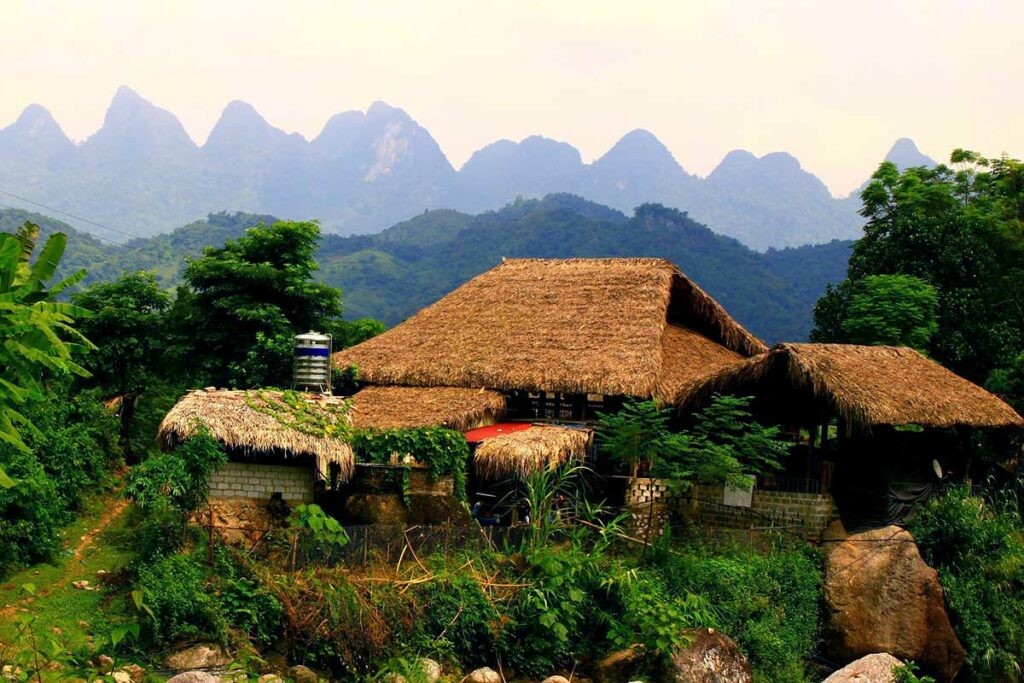 Sapa homestay with rice terraces and traditional house architecture
Sapa homestay with rice terraces and traditional house architecture
- Mai Chau: Located in Hoa Binh province, Mai Chau is known for its tranquil valleys and the White Thai ethnic group. Homestays in Mai Chau offer a relaxed atmosphere, with opportunities to cycle through picturesque villages and learn about traditional weaving techniques.
- Ha Giang: This northern province boasts stunning landscapes and diverse ethnic groups, including the Hmong, Tay, and Dao. Homestays in Ha Giang offer a chance to explore remote villages and experience the region’s unique culture.
1.3. Markets: A Hub of Culture and Commerce
Ethnic minority markets are vibrant hubs of social and economic activity. These markets are not merely places to buy and sell goods; they are vibrant displays of culture, where people from different villages gather to trade, socialize, and celebrate their heritage.
1.3.1. What to Experience at a Market
- Colorful Costumes: Witness the dazzling array of traditional costumes worn by different ethnic groups, each with its unique patterns, colors, and embellishments.
- Handicrafts and Local Products: Browse through a wide variety of handmade crafts, textiles, jewelry, and local produce, each reflecting the unique skills and traditions of the region.
- Traditional Cuisine: Sample local delicacies and street food, experiencing the diverse flavors of ethnic minority cuisine.
- Cultural Performances: Enjoy impromptu musical performances, traditional dances, and other cultural expressions that add to the vibrant atmosphere of the market.
1.3.2. Must-Visit Markets
- Bac Ha Market (Lao Cai): Held every Sunday, Bac Ha Market is one of the largest and most colorful markets in northern Vietnam, attracting members of the Flower Hmong, Tay, and Dao ethnic groups.
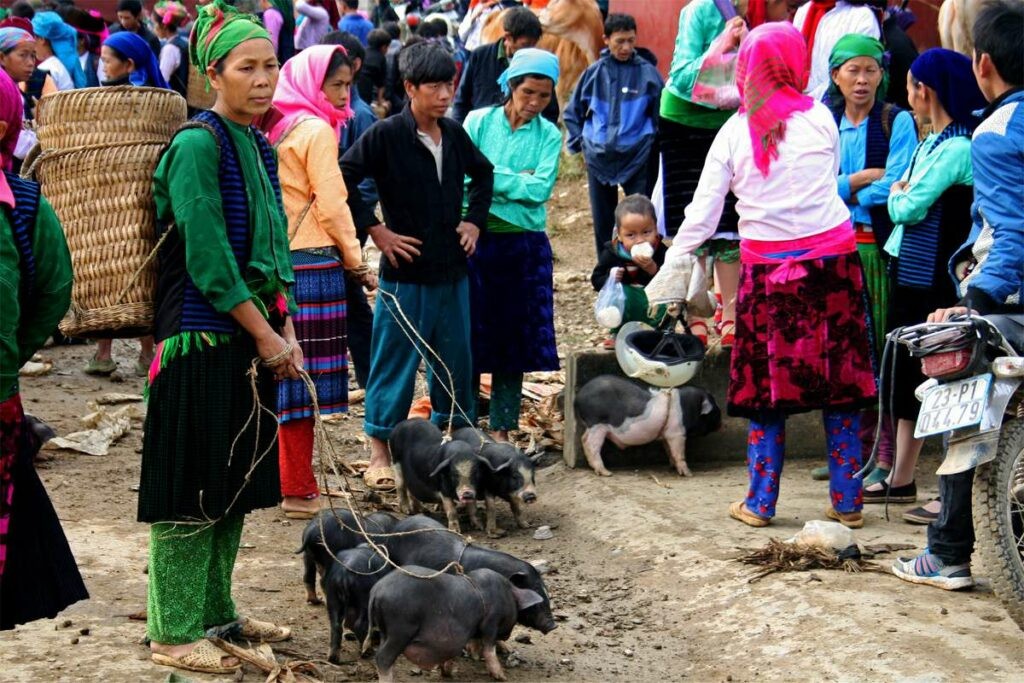 Bac Ha Market showcasing a variety of colorful textiles and traditional clothing
Bac Ha Market showcasing a variety of colorful textiles and traditional clothing
- Dong Van Market (Ha Giang): Held every Sunday in the heart of the Dong Van Karst Plateau Geopark, Dong Van Market is a bustling gathering place for the Hmong, Tay, and Dao ethnic groups.
- Khau Vai Love Market (Ha Giang): Held once a year on the 27th day of the third lunar month, Khau Vai Love Market is a unique cultural event where couples who were once in love but couldn’t be together reunite and rekindle their memories.
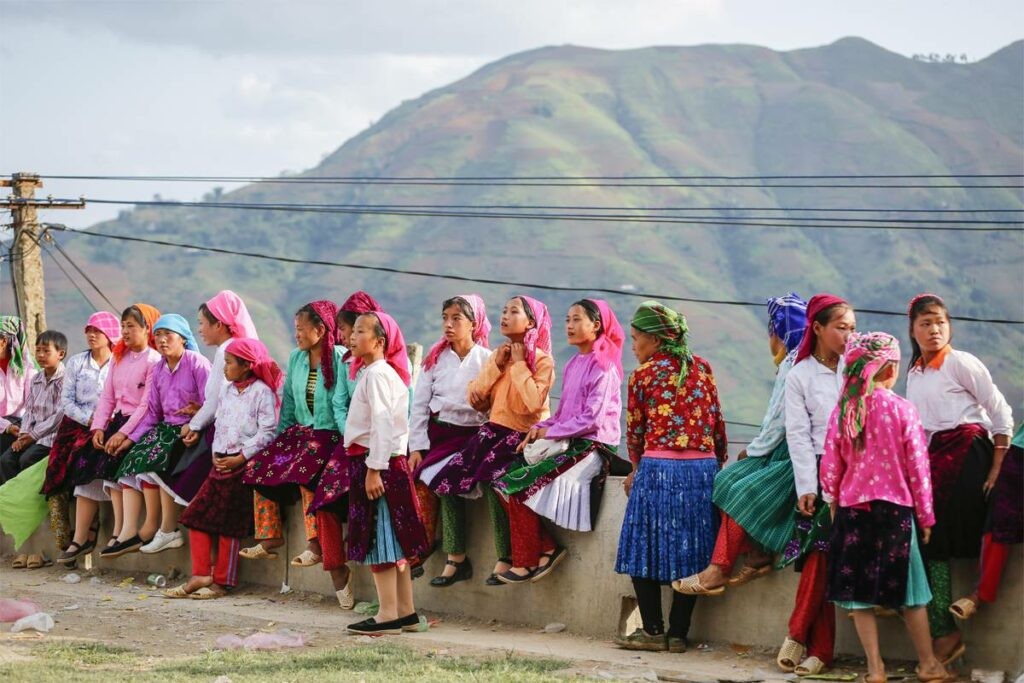 Khau Vai Love Market festival with traditional dances and cultural performances
Khau Vai Love Market festival with traditional dances and cultural performances
2. Planning Your Cultural Immersion Journey
2.1. Choosing the Right Time to Visit
The best time to visit ethnic minority regions depends on your preferences and interests.
- Dry Season (October to April): This is generally the best time to visit, with pleasant temperatures and clear skies, ideal for trekking and outdoor activities.
- Wet Season (May to September): While the wet season can bring heavy rainfall, it also transforms the landscape into lush greenery, creating stunning scenery. Be prepared for potential disruptions to travel plans due to weather conditions.
- Festivals and Events: Consider planning your trip around traditional festivals and events to witness the unique cultural celebrations of ethnic minority groups.
2.2. Essential Travel Tips
- Respect Local Customs: Dress modestly, ask permission before taking photos, and be mindful of local traditions and beliefs.
- Learn Basic Phrases: Learning a few basic phrases in the local language can go a long way in building rapport and showing respect.
- Support Local Businesses: Purchase handicrafts, souvenirs, and other products directly from local artisans and businesses to support the local economy.
- Be Prepared for Basic Amenities: Accommodation and facilities in remote areas may be basic, so be prepared for simple living conditions.
- Book in Advance: Homestays and tours can fill up quickly, especially during peak season, so it’s advisable to book in advance.
2.3. How SIXT.VN Can Enhance Your Experience
SIXT.VN is your trusted partner for seamless and enriching travel experiences in Vietnam. We offer a range of services designed to enhance your cultural immersion journey:
- Airport Transfers: Start your journey with ease and comfort with our reliable airport transfer services.
- Hotel Booking: Choose from a curated selection of hotels that cater to your budget and preferences.
- Tours and Activities: Discover our diverse range of tours and activities that delve into the heart of Vietnamese culture.
- Visa Assistance: Let us assist you with your visa application to ensure a hassle-free entry into Vietnam.
3. Delving Deeper: Beyond Homestays and Markets
While homestays and market visits offer excellent starting points, there are numerous other ways to immerse yourself in the daily life of ethnic minority groups in Vietnam.
3.1. Trekking with an Ethnic Minority Guide
Embarking on a trek with a local guide offers unparalleled insights into the region’s culture, history, and natural environment.
3.1.1. Benefits of Trekking with a Local Guide
- Expert Knowledge: Local guides possess in-depth knowledge of the region’s flora, fauna, and cultural significance.
- Language and Communication: Guides can bridge the language gap, facilitating communication with local communities.
- Safety and Navigation: Guides ensure your safety and navigate through challenging terrains, minimizing risks.
- Cultural Immersion: Guides share personal stories, insights, and cultural perspectives, enhancing your understanding.
3.1.2. Popular Trekking Destinations
- Sapa: Offers treks through rice terraces and mountainous landscapes, showcasing the culture of the Hmong and Dao people.
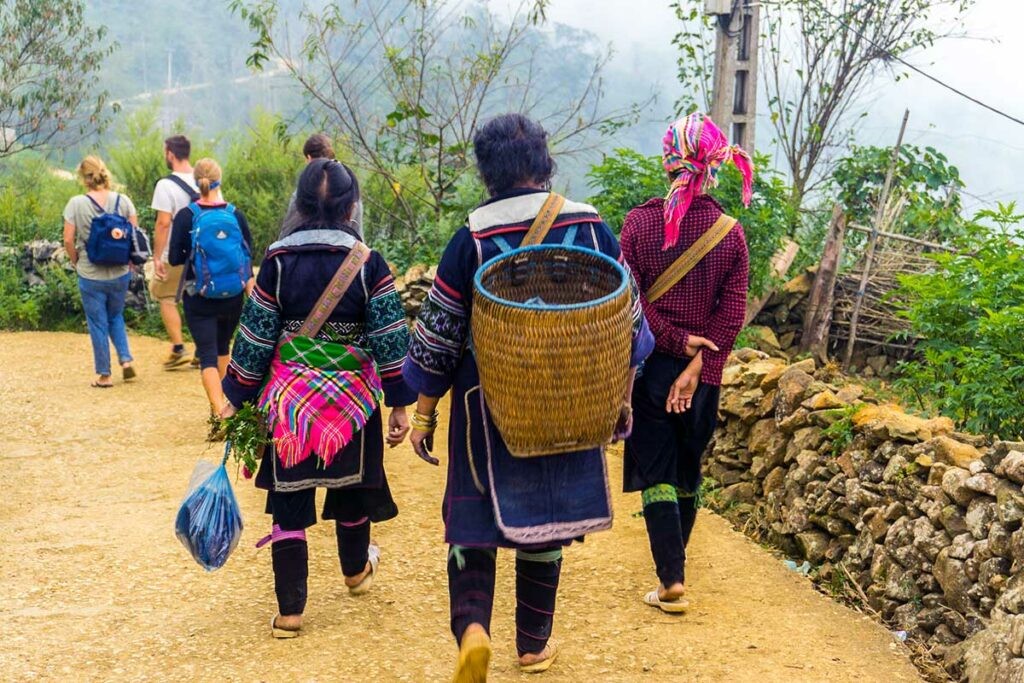 Trekking through rice terraces in Sapa with local Hmong guides
Trekking through rice terraces in Sapa with local Hmong guides
- Ha Giang: Known for its challenging treks through the Dong Van Karst Plateau Geopark, providing insights into the lives of the Tay and Nung communities.
- Pu Luong Nature Reserve: Offers treks through lush forests and traditional villages, showcasing the culture of the Thai and Muong ethnic groups.
3.2. Visiting Local Handicraft Villages
Explore the artistry and craftsmanship of ethnic minority communities by visiting local handicraft villages.
3.2.1. Types of Handicrafts
- Textiles: Witness the intricate weaving and dyeing techniques used to create traditional clothing, blankets, and other textiles.
- Pottery: Observe the creation of unique pottery items, from simple household utensils to elaborate decorative pieces.
- Wood Carving: Admire the intricate carvings on wooden furniture, sculptures, and other decorative items.
- Jewelry: Explore the artistry of traditional jewelry making, using silver, beads, and other materials.
3.2.2. Destinations for Handicraft Enthusiasts
- Bat Trang Pottery Village (Hanoi): While not an ethnic minority village, Bat Trang offers a glimpse into the traditional pottery making techniques of Vietnam.
- Van Phuc Silk Village (Hanoi): Witness the silk weaving process and purchase high-quality silk products.
- My Nghiep Cham Village (Ninh Thuan): Learn about the traditional weaving techniques of the Cham people, an ethnic minority group in southern Vietnam.
 A woman in Ha Giang weaving traditional textiles with a traditional loom
A woman in Ha Giang weaving traditional textiles with a traditional loom
3.3. Participating in a Cooking Class
Discover the unique flavors of ethnic minority cuisine by participating in a cooking class.
3.3.1. What You’ll Learn
- Traditional Ingredients: Learn about the unique ingredients and spices used in ethnic minority cuisine.
- Cooking Techniques: Master traditional cooking techniques passed down through generations.
- Cultural Significance: Understand the cultural significance of different dishes and their role in local traditions.
- Hands-on Experience: Prepare and cook traditional dishes under the guidance of local experts.
3.3.2. Popular Cooking Class Destinations
- Sapa: Offers cooking classes focusing on the cuisine of the Hmong and Dao people, using fresh, local ingredients.
- Hoi An: While not an ethnic minority region, Hoi An offers cooking classes that incorporate elements of Vietnamese cuisine influenced by ethnic minority traditions.
- Hue: Explore the royal cuisine of Hue, which incorporates unique ingredients and cooking techniques.
3.4. Volunteering with a Local Community Project
Make a meaningful contribution to local communities by volunteering with a local project.
3.4.1. Types of Volunteer Opportunities
- Teaching English: Assist local students with their English language skills.
- Construction: Help build or renovate schools, homes, or community centers.
- Farming: Participate in agricultural activities, learning about traditional farming techniques.
- Healthcare: Assist local healthcare providers with basic medical care and health education.
3.4.2. How to Find Volunteer Opportunities
- Contact Local NGOs: Research and contact local NGOs that work with ethnic minority communities.
- Volunteer Placement Agencies: Utilize volunteer placement agencies to find suitable volunteer opportunities.
- Homestay Hosts: Inquire with your homestay hosts about potential volunteer opportunities in the community.
3.5. Visiting the Vietnam Museum of Ethnology
Gain a comprehensive understanding of the diverse ethnic groups of Vietnam by visiting the Vietnam Museum of Ethnology in Hanoi.
3.5.1. What to Expect at the Museum
- Indoor Exhibits: Explore exhibits showcasing traditional clothing, tools, musical instruments, and religious artifacts.
- Outdoor Exhibits: Wander through outdoor recreations of traditional houses from different ethnic groups.
- Educational Programs: Participate in educational programs and events that provide deeper insights into ethnic minority cultures.
3.5.2. Key Exhibits
- Traditional Houses: Explore recreations of traditional houses from different ethnic groups, showcasing their unique architectural styles and living spaces.
- Clothing and Textiles: Admire the intricate patterns and designs of traditional clothing and textiles, reflecting the unique cultural identities of different ethnic groups.
- Ritual Objects: Learn about the religious beliefs and practices of ethnic minority groups through exhibits of ritual objects and artifacts.
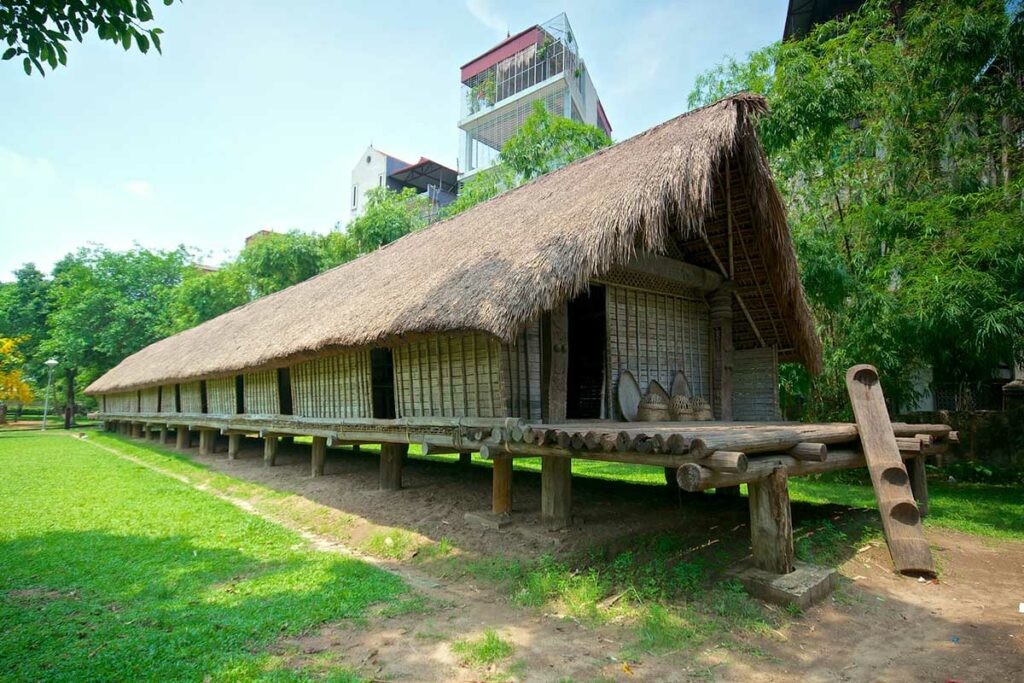 Outdoor exhibit at the Vietnam Museum of Ethnology showcasing a traditional house
Outdoor exhibit at the Vietnam Museum of Ethnology showcasing a traditional house
4. Responsible and Sustainable Tourism
As you embark on your cultural immersion journey, it’s essential to practice responsible and sustainable tourism.
4.1. Respecting Local Culture and Traditions
- Dress Modestly: Dress respectfully when visiting religious sites and local communities.
- Ask Permission: Seek permission before taking photos of people or entering private property.
- Learn Basic Phrases: Learn a few basic phrases in the local language to show respect and facilitate communication.
- Be Mindful of Customs: Be aware of local customs and traditions, and avoid behaviors that may be considered offensive.
4.2. Supporting Local Economies
- Purchase Local Products: Buy handicrafts, souvenirs, and other products directly from local artisans and businesses.
- Eat at Local Restaurants: Dine at local restaurants and sample traditional cuisine.
- Stay in Local Accommodations: Choose homestays and locally owned hotels to support the local economy.
- Hire Local Guides: Employ local guides and tour operators to benefit from their expertise and contribute to their livelihoods.
4.3. Minimizing Environmental Impact
- Reduce Waste: Avoid single-use plastics and dispose of waste responsibly.
- Conserve Water and Energy: Be mindful of your water and energy consumption.
- Respect Wildlife: Observe wildlife from a distance and avoid disturbing their natural habitat.
- Support Eco-Friendly Practices: Choose tour operators and accommodations that prioritize environmental sustainability.
5. Addressing Common Concerns and Misconceptions
Many travelers harbor concerns and misconceptions about visiting ethnic minority regions. Addressing these issues can enhance understanding and promote responsible travel.
5.1. Safety and Security
While some remote areas may have limited infrastructure, ethnic minority regions are generally safe for tourists. However, it’s essential to exercise caution and be aware of your surroundings.
- Travel in Groups: Consider traveling in groups or with a guide, especially in remote areas.
- Inform Someone of Your Plans: Let someone know your itinerary and expected return date.
- Secure Your Valuables: Keep your valuables in a safe place and be aware of petty theft.
- Follow Local Advice: Heed the advice of local authorities and guides regarding safety precautions.
5.2. Language Barriers
Language barriers can pose challenges, but they shouldn’t deter you from exploring ethnic minority regions.
- Learn Basic Phrases: Learning a few basic phrases in the local language can facilitate communication and show respect.
- Use Translation Apps: Utilize translation apps on your smartphone to communicate with locals.
- Hire a Local Guide: Employ a local guide who can act as a translator and interpreter.
- Be Patient and Understanding: Be patient and understanding when communicating with people who don’t speak your language.
5.3. Cultural Sensitivity
Respecting local culture and traditions is paramount when visiting ethnic minority regions.
- Dress Modestly: Dress respectfully when visiting religious sites and local communities.
- Ask Permission: Seek permission before taking photos of people or entering private property.
- Avoid Controversial Topics: Refrain from discussing sensitive or controversial topics that may offend local customs.
- Be Open-Minded and Respectful: Approach cultural differences with an open mind and respect for local customs and beliefs.
5.4. Economic Impact
Tourism can have both positive and negative impacts on local economies. It’s essential to support sustainable tourism practices that benefit local communities.
- Purchase Local Products: Buy handicrafts, souvenirs, and other products directly from local artisans and businesses.
- Eat at Local Restaurants: Dine at local restaurants and sample traditional cuisine.
- Stay in Local Accommodations: Choose homestays and locally owned hotels to support the local economy.
- Negotiate Fair Prices: Negotiate prices fairly, avoiding excessive bargaining that may undervalue local products and services.
6. Personal Stories and Testimonials
Hearing from other travelers who have experienced the daily life of ethnic minority groups can inspire and inform your own journey.
6.1. Sarah’s Homestay Experience in Sapa
“Staying with a Hmong family in Sapa was the highlight of my trip to Vietnam. I learned about their traditional farming practices, helped prepare meals, and shared stories around the fire. It was an unforgettable experience that gave me a deeper understanding of their culture and way of life.”
6.2. Mark’s Market Adventure in Bac Ha
“Visiting Bac Ha Market was like stepping into a kaleidoscope of colors and sounds. I was amazed by the vibrant costumes, the variety of local products, and the energy of the crowd. It was a sensory overload in the best possible way.”
6.3. Emily’s Trekking Experience in Ha Giang
“Trekking through the Dong Van Karst Plateau Geopark with a local guide was challenging but incredibly rewarding. I learned about the history of the region, discovered hidden waterfalls, and connected with the local communities along the way. It was an adventure that pushed me out of my comfort zone and broadened my horizons.”
6.4. David’s Volunteer Experience in Mai Chau
“Volunteering at a local school in Mai Chau was a humbling experience. I helped teach English to the students and learned about their aspirations and challenges. It was a meaningful way to give back to the community and make a positive impact.”
7. Future Trends in Ethnic Minority Tourism
Ethnic minority tourism is evolving, with new trends emerging that offer more immersive and sustainable experiences.
7.1. Community-Based Tourism
Community-based tourism (CBT) is gaining popularity, empowering local communities to manage and benefit from tourism activities. CBT initiatives often involve homestays, guided tours, handicraft production, and cultural performances.
7.2. Experiential Travel
Travelers are increasingly seeking authentic and experiential travel experiences that go beyond traditional sightseeing. Experiential travel in ethnic minority regions may involve participating in traditional ceremonies, learning local crafts, or helping with farming activities.
7.3. Sustainable Tourism Practices
Sustainable tourism practices are becoming more important as travelers become more aware of the environmental and social impacts of tourism. Sustainable tourism initiatives in ethnic minority regions may involve reducing waste, conserving water and energy, and supporting local businesses.
7.4. Digital Technology
Digital technology is playing an increasingly important role in ethnic minority tourism. Online platforms and social media are used to promote tourism destinations, connect travelers with local communities, and provide information about cultural events and activities.
8. Conclusion: Embrace the Authentic Beauty of Vietnam’s Ethnic Minorities
Experiencing the daily life of ethnic minority groups in Vietnam offers an extraordinary opportunity to connect with diverse cultures, broaden your perspectives, and create lasting memories. Whether you choose to stay in a traditional homestay, explore vibrant markets, embark on a trekking adventure, or volunteer with a local community project, remember to travel responsibly and respectfully, supporting local economies and minimizing your environmental impact.
SIXT.VN is committed to providing you with seamless and enriching travel experiences in Vietnam. From airport transfers to hotel bookings, tours and activities to visa assistance, we are your trusted partner for exploring the authentic beauty of Vietnam’s ethnic minorities. Contact us today to start planning your unforgettable journey!
Address: 260 Cau Giay, Hanoi, Vietnam
Hotline/Whatsapp: +84 986 244 358
Website: SIXT.VN
9. Frequently Asked Questions (FAQs)
9.1. What is the best time to visit ethnic minority regions in Vietnam?
The best time to visit is during the dry season (October to April) for pleasant weather, but festivals throughout the year offer unique cultural experiences.
9.2. How can I find a reputable homestay in Sapa?
SIXT.VN offers a curated selection of homestays in Sapa that ensure comfort and authentic cultural experiences.
9.3. What should I wear when visiting a local market?
Dress modestly and respectfully. Comfortable shoes are recommended for walking around the market.
9.4. Is it safe to trek in Ha Giang without a guide?
It’s recommended to trek with a local guide for safety and to enhance your understanding of the local culture and environment.
9.5. How can I support local artisans when visiting handicraft villages?
Purchase products directly from local artisans and avoid excessive bargaining to ensure fair prices.
9.6. What are some essential Vietnamese phrases I should learn?
“Xin chào” (hello), “Cảm ơn” (thank you), and “Tạm biệt” (goodbye) are useful phrases to start with.
9.7. How can I ensure my tourism is sustainable and benefits the local community?
Choose local accommodations, eat at local restaurants, and participate in community-based tourism initiatives.
9.8. What types of food should I try when visiting ethnic minority regions?
Try local specialties like “thang co” (horse meat stew) in Sapa or “com lam” (bamboo rice) in the Central Highlands.
9.9. Are there any cultural etiquette tips I should keep in mind?
Avoid pointing your feet at people, ask permission before taking photos, and be mindful of noise levels in quiet villages.
9.10. How can SIXT.VN help me plan my trip to ethnic minority areas?
SIXT.VN offers comprehensive travel services, including airport transfers, hotel bookings, tours, and visa assistance, ensuring a seamless and enriching cultural experience.



